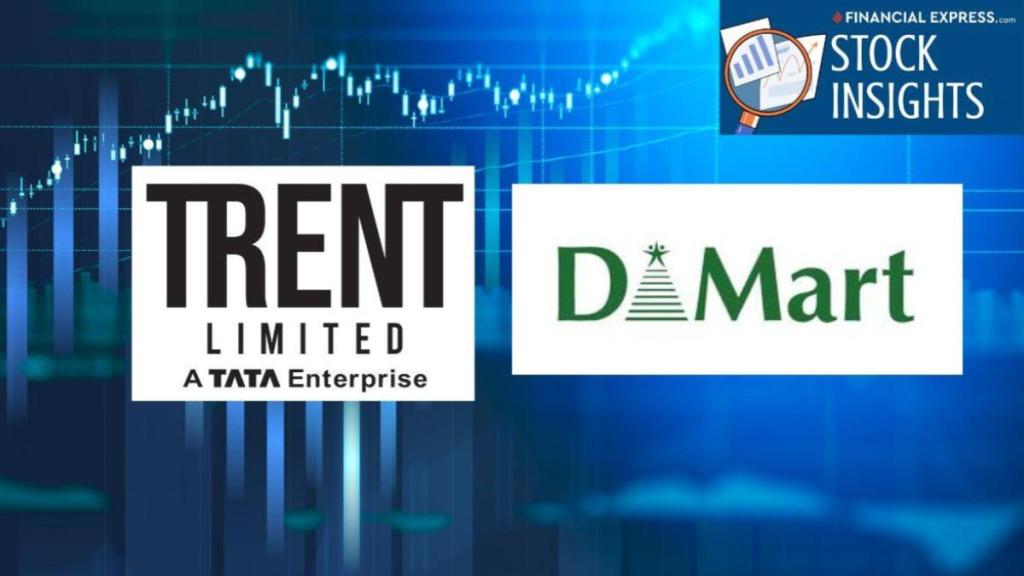A question that investors on Dalal Street are increasingly asking – has the red-hot sales growth for leading retail chains showing signs of cooling off?
The above development comes at a time with consumers increasingly turning cautious — several sectors including the IT, diamond and textiles have been facing a rather difficult operating environment amidst the global trade tensions with the Trump administration and growing signs of employees being laid off.
Leading retail chains have traded at a P/E of more than 70 times for nearly a decade and investors are increasingly reassessing the growth prospects and valuations of these stocks.
And the Trent stock price hit a 52-week low of Rs 4,491.75 on 7 April 2025 and had subsequently ended on Thursday 0.5 % lower at Rs 5,370. Trent operates the Westside retail chain along with Zudio and Star Bazaar.
Similarly, Avenue Supermarts, which operates DMart chain, saw its stock price hit a 52-week low of Rs 3,337 on 3 March 2025 and it ended Thursday’s trade 0.5 % higher at Rs 4,353.9.
The First Cracks Appear: A Look at the Q1 Slowdown
Sales growth momentum has showed signs of slowing in the June 2025 quarter.
Trent’s consolidated revenue from operations grew nearly 19 % y-o-y to Rs 4,883.48 crore in the June 2025 quarter. Its consolidated operating profit grew nearly 38.3 % y-o-y to Rs 848 crore during the June 2025 quarter while consolidated net profit grew nearly 8.4 % y-o-y to Rs 424.7 crore during the quarter under review.
And during FY 25, Trent’s consolidated revenue from operations grew nearly 38.5 % y-o-y to Rs 17, 134.6 crore. Its consolidated operating profit grew 43.5 % y-o-y to Rs 2,760 crore during FY 25 while consolidated net profit grew 3.9 % y-o-y to Rs 1,534.4 crore during FY 25.
A similar trend has also been observed for Avenue Supermarts, which operates the DMart chain of retail stores. Its consolidated revenue from operations grew 16.3 % y-o-y to Rs 16, 359.7 crore in the June 2025 quarter. The company has highlighted that it’s like-for- like growth was 7.1 % in the June 2025 quarter vis-a-vis 9.1 % in the June 2024 quarter. Like for like growth refers to growth in revenue from sales of stores which have been operational for atleast 24 months at the end of reporting period
And during FY 25, Avenue Supermarts’ consolidated income from operations grew nearly 16.9 % y-o-y to Rs 59,358 crore. The company has highlighted that it’s like-for-like growth was 8.4 % during FY 25 as compared to 9.9 % during FY24.
Building Bigger, But is it Better? The Store Expansion Dilemma
Trent launched its newest fashion brand, Burnt Toast and the first store of this youth centric brand was recently launch in Bangalore.
Trent had 1,043 stores at the end of June 2025 quarter with an area of nearly 13.6 million sq ft vis-a-vis 890 stores a year earlier with an area of 11 million sq ft
Meanwhile, Avenue Supermarts had 424 operating stores with an area of nearly 17.2 million sq ft at the end of the June 2025 quarter vis-a-vis 371 stores with an area of 15.4 million sq ft a year earlier
Investors will be closely monitoring the retail chains store expansion strategy as well consumer spending patterns over the next few quarters
The Billion-Dollar Question: Can High Valuations Survive Slowing Growth?
Trent trades at a P/E of nearly 108 times estimated consolidated FY 26 earnings. The stock has traded at a P/E of more than 100 times for nearly a decade, according to data sourced from Screener.
Avenue Supermarts trades at a P/E of nearly 72 times estimated consolidated FY 26 earnings. It has traded at a P/E of more than 70 times for more than 8 years, according to data sourced from Screener.
Clearly, retail stocks appear expensive at a time when consumers are thinking twice before spending.
Amriteshwar Mathur is a financial journalist with over 20 years of experience.
The writer and his family have no shareholding in any of the stocks mentioned in the article.
Disclaimer: The website managers, its employee(s), and contributors/writers/authors of articles have or may have an outstanding buy or sell position or holding in the securities, options on securities or other related investments of issuers and/or companies discussed therein. The content of the articles and the interpretation of data are solely the personal views of the contributors/ writers/authors. Investors must make their own investment decisions based on their specific objectives, resources and only after consulting such independent advisors as may be necessary.

